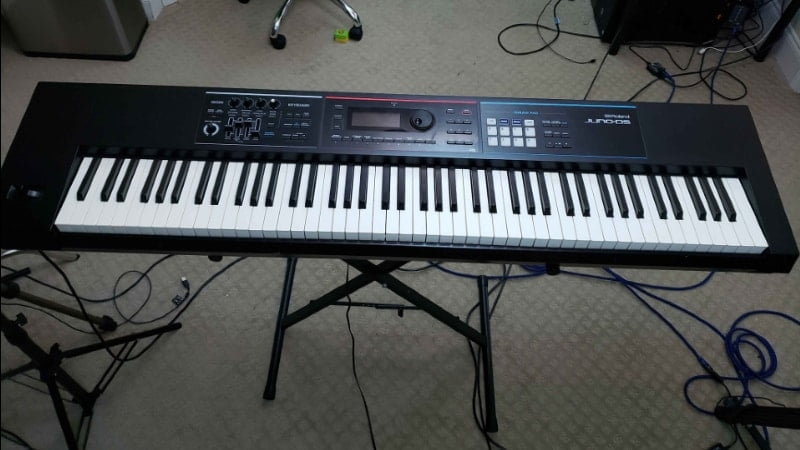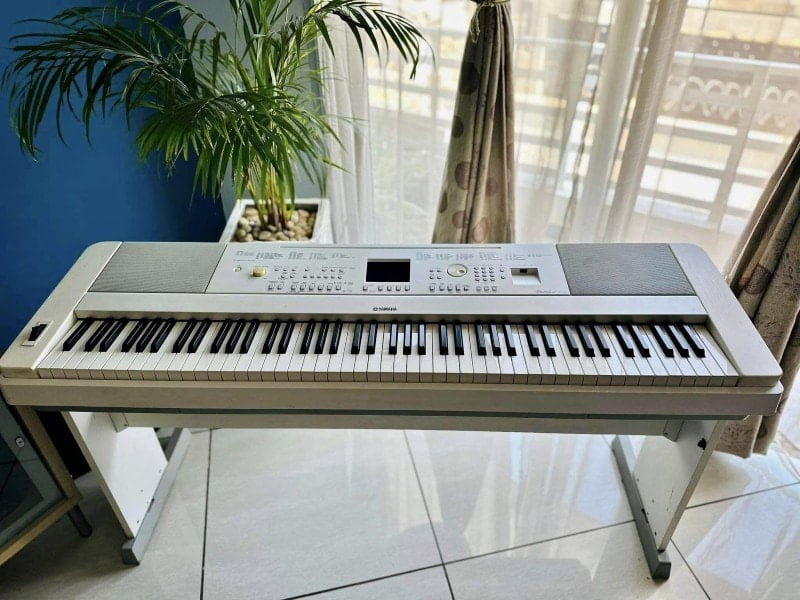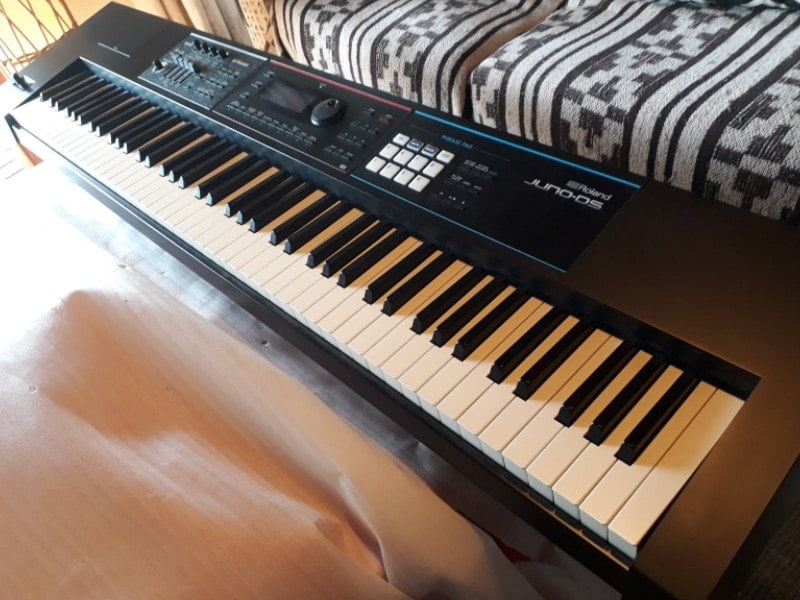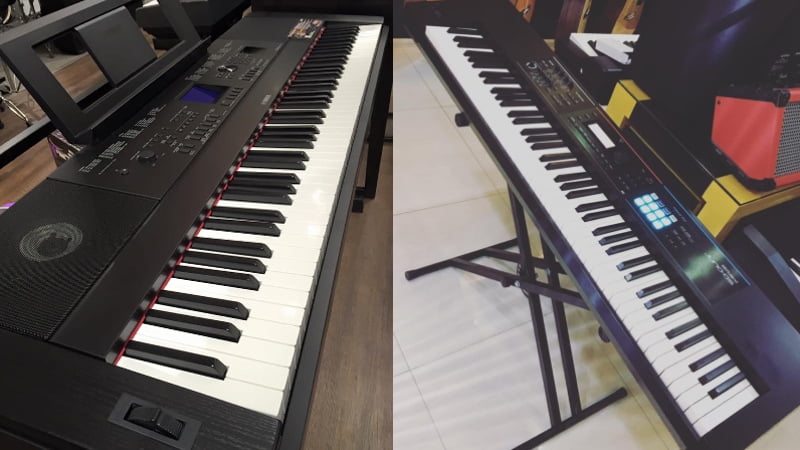Find the best digital piano for your needs in this Yamaha DGX-660 vs Roland Juno DS-88 review.
The Yamaha DGX-660 and the Roland Juno DS-88 couldn’t be more different from each other. These are two digital pianos designed for different needs, with their own set of advantages and disadvantages.
So, which piano is the better pick?
Well, that depends on your needs. The Roland Juno DS-88 is excellent for pianists who play many modern music styles. But if you’re looking for a reliable digital piano with some of the most realistic piano tones available, the Yamaha DGX-660 is the better option.
Of the two, I prefer the Yamaha DGX-660. And in this Yamaha DGX-660 vs Roland Juno DS-88 review, I explain why.
Below, I get into the features and details of both pianos. That way, you get a clear picture of who the pianos are made for and where they can be used the most effectively. And by the end, you’ll know exactly which digital piano to buy to fulfill your needs!
Yamaha DGX-660 vs Roland Juno DS-88: Comparison Chart




Last update on 2024-07-27 / Affiliate links / Images from Amazon Product Advertising API
Yamaha DGX-660 vs Roland Juno DS-88: A Head-to-Head Comparison
I always judge digital pianos based on three main comparison points: tone, feel, and polyphony. In this comparison, the Yamaha DGX-660 came out on top with a score of 3-1, giving it a very narrow win.
As you can tell, this was a very close fight. The main reason for this was that these are very different instruments designed for different pianists. In the section below, I’ll go through these main features and show you why I prefer the DGX-660.
Tone
The winner: Tie
Just ask any pianist out there, and they will likely tell you that the piano’s tone is its most important feature. Whether you’re talking about acoustic or digital pianos, this statement remains true. And when comparing the DGX-660 to the Juno DS-88, I couldn’t pick a winner.
While the DGX-660 had more realistic and crisp piano tones, the Juno DS-88 offers a huge variety of sounds, making it the more versatile option. In the next section, I’ll get into more detail about the tone of both pianos so you can easily determine which one is best suited to your needs.

+Tone Generation
The first thing I looked at was the tone generator or tone engine of either piano. This is where the Yamaha DGX-660 truly shined. This is because this piano comes with the Yamaha Pure CF Sound Engine, which derives its piano sounds from real Yamaha CF Grand Pianos.
There’s a high chance you’ve heard a Yamaha CF Grand Piano before. These pianos are some of the most popular grand pianos on the market and are known for their bright and crisp piano tones. Yamaha paid very close attention when recording the sounds from these pianos, as whenever I pressed a key on the Yamaha DGX-660, the sound would be very close to the sound of a real grand piano.
This is really surprising, especially in this price range, as most of the models in this range consist of artificial, digital-sounding tones.
And while the Roland Juno DS-88 doesn’t produce these types of digital tones, there’s no denying that it doesn’t sound as realistic as the Yamaha DGX-660. The Roland model comes with the SuperNatural piano sound, which is a bit more realistic than others in this price range, but it falls short of the Yamaha DGX-660.
+Sound Library
The Roland Juno DS-88 is the clear winner when it comes to the sound library. This is because it sports a massive sound library of over 1,000 tones. This piano is designed for versatile pianists that need a lot of variety in their tones. So, you can find lead synths, arpeggiators, pianos, strings, and just about any sound you’ll need.
This makes the Roland Juno DS-88 a great gigging piano. You won’t run out of voices and presets with instruments. And unlike other pianos with massive sound libraries, I found that the sound quality remained relatively consistent throughout all the voices, making it a great pick for just about anyone.
The Yamaha DGX-660, while it doesn’t have the same variety, still has a huge sound library. It’s packed with over 550 different voices, which is more than enough for most pianists. However, not all of these voices utilize the Pure CF Sound Engine, which is why you’ll notice a clear dip in quality when you scroll through the voices.
Because of this, I couldn’t award the point only to the Yamaha. Instead, I gave each of the pianos a point in this comparison as they each have their own advantages and drawbacks.
Feel
The winner: Yamaha DGX-660
Most of the time, people buying a digital piano look for one with a realistic feel. And since the Yamaha DGX-660 comes with a more sophisticated hammer action, it does a much better job of replicating the feel of a real acoustic piano.

+Hammer Action
The Roland Juno DS-88 only comes with an Ivory-Feel G hammer action. This is a system that you’ll only find on Roland pianos, and it’s nothing short of unique. This hammer action is a bit softer than those on acoustic pianos, as the Juno DS-88 isn’t necessarily designed to replicate the sound and feel of an acoustic piano. Instead, it’s meant to feel like a completely different instrument.
That said, this hammer action provides some weight to it with a very realistic spring-back. And while this wasn’t exactly the type of hammer action I was looking for, there are many pianists out there that might prefer this over the Yamaha DGX-660’s action.
Speaking of, the Yamaha comes with the Graded Hammer Standard, one of the most popular options on the market. This hammer action replicates the slight weight differences you’ll feel on an acoustic piano, and it does a great job at it.
When I played the Yamaha, it almost felt like I was playing an acoustic piano. This really helps with my playing as I need the weight of a real acoustic piano to play my best. So, if you want a realistic feel with your digital piano, I’d recommend the Yamaha DGX-660.
Polyphony
The winner: Yamaha DGX-660
The last feature I considered was the polyphony. This is a very important piano feature as it determines how many notes the piano can play simultaneously. And between these two options, the Yamaha DGX-660 was the clear winner.
The Roland model comes with 128-note polyphony. And to be honest, this was a slight let-down. At this price point, I would expect the piano to come with a much better polyphony. However, if you don’t play that many pieces that require dense chords and many simultaneous notes, this polyphony should be fine.
But if you’re looking for a bit more flexibility, the Yamaha DGX-660 would be a better pick. With 192-note polyphony, you won’t have any problems playing large groups of notes simultaneously. And because of this, I gave the point to the Yamaha, which resulted in this model winning the overall comparison.

Yamaha DGX-660 vs Roland Juno DS-88: The Similarities
There are a few similarities between these two pianos. To start, they both have large sound libraries designed for versatile pianists. And since they are portable models, they are great picks for pianists that need to bring their instrument to gigs, practice, or piano lessons.
On top of that, these pianos are packed with different playing modes. That way, you can blend voices together, divide the piano into two zones with different voices, or split the keyboard into twin pianos for duets and piano lessons.
All in all, both of these pianos are great picks for any musician. However, they are definitely made for different pianists.
If you’re looking for a more traditional option with top-of-the-line piano tones, the Yamaha would be a better pick. But if you’re looking for a piano loaded with different voices like synths and strings, the Roland Juno DS-88 would be a better pick.
Quick Rundown of the Yamaha DGX-660
- The Pure CF Sound Engine faithfully reproduces the tone of a meticulously sampled and highly acclaimed Yamaha concert grand piano
- GHS weighted action is heavier in the low register and lighter in the high, just like an acoustic piano
- Score display puts music notation of MIDI songs on the screen, helping you play your favorites by following the bouncing ball
- The Piano room lets you choose from a variety of pianos and acoustic settings to create your own personal piano environment
- The 6 track recorder allows you to capture your performances and song ideas, then add additional layers to spice up your pieces
Last update on 2024-07-27 / Affiliate links / Images from Amazon Product Advertising API
Quick Rundown of the Roland Juno DS-88
- Gig-ready instrument with pro sounds, enhanced performance features, and battery-powered operation
- 88-note Ivory Feel-G Keyboard provides weighted-action feel in a lightweight design that’s easy to transport
- Includes all the sounds from the popular JUNO-Di, plus newly updated acoustic and electric pianos, additional organs, and other stage essentials
- Wave expansion slot enables users to download new sound waveforms, available for free at Roland’s Axial website
- Sample import function for playing user WAV files on the JUNO-DS88’s keyboard
Last update on 2024-07-27 / Affiliate links / Images from Amazon Product Advertising API
Product Video
Related Articles to Yamaha Dgx 660
- Yamaha YDP-164 vs DGX-660: Why You Should Go for the DGX-660
- Yamaha DGX-660 vs Roland FP-90: Why the Roland FP-90 Is the Better Pick
- Yamaha DGX-530 vs 660: Why the DGX-660 Is the Better Pick
- Yamaha DGX-505 vs 660: Why the DGX-660 Is the Better Pick
- Yamaha DGX-660 vs DGX-640: A DGX Comparison
- Yamaha DGX-660 vs DGX-630: A DGX Comparison
- Yamaha DGX-620 vs 660: Finding the Best DGX Model
- Yamaha DGX-660 vs YDP-163: Which Is the Better Piano?
- Yamaha DGX-660 vs Casio PX-360: Which Is the Better Piano?
- Yamaha DGX-660 vs YDP-144: Which Is the Better Yamaha Piano?
- Yamaha DGX-660 vs Korg Havian 30: Which Is the Better Digital Piano?
- Yamaha DGX-660 vs Casio CGP-700: Which Is the Better Pick?
- Yamaha DGX-660 vs YPG-535: Finding the Best Yamaha Digital Piano
- Yamaha DGX-660 vs P515: Is the P515 Worth the Extra Cost?
- Yamaha DGX-660 vs P-115: Which Yamaha Model Is Better?
- Yamaha DGX-660 vs Casio PX-560: Which Piano Offers More Value For The Money
- Yamaha DGX-660 vs 650: A DGX Comparison
- Korg XE-20 vs Yamaha DGX-660: Finding the Best Digital Piano
- Yamaha P45 Vs DGX-660: A Head-to-Head Comparison
- Yamaha DGX 670 Vs 660: The Distinct Difference In Details You Need To Know About
- Yamaha YDP-103 Vs DGX-660: Which Is The Better Yamaha Piano?
- Casio PX-770 Vs Yamaha DGX-660: Should You Get A Portable Or Console Digital Piano?
- Yamaha P71 vs DGX-660: Can the Amazon Exclusive Beat Out the Premium Model?
- Yamaha P125 vs DGX 660 Comparison: Can the P125 Hold Its Own Against the DGX 660?
References:
- Yamaha DGX-660: https://usa.yamaha.com/products/musical_instruments/pianos/p_series/dgx-660/index.html
- Roland Juno DS-88: http://www.bhphotovideo.com/c/product/1186585-REG/roland_juno_ds_88_88_note_synthesizer.html/specs
Lulacruza is an electronic folk duo operating at the junction of the hypermodern and the ancient. Our music weaves together hypnotic female singing, South American folk instruments and electronic processing, while channeling pulsating waves from the source of creation.
Lalucruza is also a community where you can connect with other music lovers to collaborate, exchange ideas and share knowledge. A platform for who wants to learns the basics of playing piano, guitar, drum masters’ technique, etc.. is the premise of our website.
